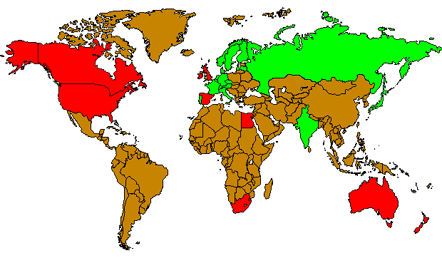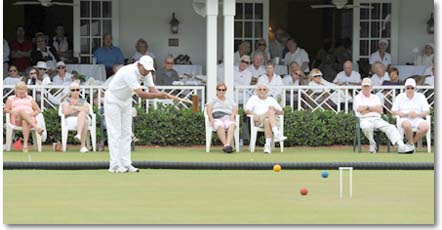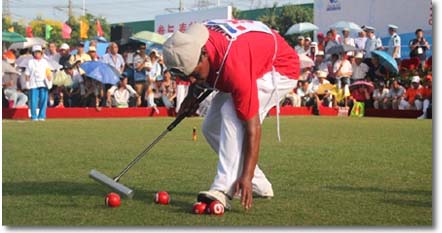

|
Back to |
| The Front Page |
| News & Features |

|
The WCF aims for the World Games: an interview with Sec-Gen Martin French |
|
by Bob Alman photos by Johnny Mitchell, Alex Park, and others as cited WCF map and story layout by Reuben Edwards Posted February 11, 2013
|
Aspiring to compete in the Olympic Games, the World Games, or the Commonwealth Games requires including reaching a minimum level of representation--at least 40 countries on five continents. By allying with the World Gateball Union under the banner of "The World Federation of Mallet Sports," both croquet and gateball could meet that bar. In some countries, including Australia and Switzerland, the two sports already have a formalized relationship, with players who compete in both codes working to maximize the benefits of greater cooperation. Representatives of both sports agree that competing in the major Games would confer upon them vastly greater visibility on a global scale. Whether and when the two mallet sports organizations reach a formal agreement to that end are the main questions to be answered in a future story.
BOB ALMAN: Mike Orgill did a Croquet World interview with Chris Hudson, first Secretary-General of the WCF, in 1996, which included all the reasons he gave for croquet's failure to be recognized as a sport worthy of inclusion in any of the major multi-sports events: The Olympics, the World Games, the Commonwealth Games. I'd like to start by picking up each of Hudson's reasons and bringing them up to date, as a measure of 17 years of progress. First, Hudson comments that for the World Games, you need twenty countries, spread across five continents. The score then, for the WCF, was 20 countries, spread across four continents. What is it today, in 2013?
MARTIN FRENCH: The score today is much improved: we have 30 Member associations in 30 countries, spread across 5 continents: Australia, North America, Europe, Africa, and Asia. South America is the main “croquet desert”. Three of those 30 Members have joined in the last two years, and I get regular enquiries (recent ones from Nederlands, Kenya, Bangladesh, for example) from people hoping to start a national association.
BOB: But that doesn't mean you're sitting by the phone waiting for the Olympic Committee to call, I gather.
MARTIN: No, because the bar has risen over the last 17 years. As far as I can find out, you now need 40 countries, rather than 20, to be considered for the World Games or the Olympics. The second point Chris Hudson made is still very valid: exactly which sports are included in any staging of these Games depends on what facilities the host is prepared to include in their bid. So simply reaching 40 Members will not guarantee us access to the World or Commonwealth Games, until a host decides to offer the right facilities.

|
|||
| The WCF has ten full members (shown in red) and 20 Associate and Observer member countries (in green) belong to croquet's worldwide organizing body. | |||
|
BOB: That wouldn't be a problem if the host city happens to have a large and active croquet club, and if the host country decides they want croquet to be included--for example, London (for the 2012 Olympics) or Glasgow (for the Commonwealth Games in 2014). Of course, those opportunities are lost for now, but by the time those countries come up again as a host, croquet should be ready to make a strong case. It's my understanding that the host city has the final say as to which sports are included, and they're somewhat different, every four years.
| HUDSON & ORGILL INTERVIEW, 1996 |
|
Hudson: Croquet was a demonstration sport at the World Games in Karlsruhe in 1986. However, for croquet to be included as a sport in future World Games, the WCF would have to have at least 20 member countries, spread across the five continents. There is also a difficulty that a sport can only be included in the World Games if the facilities required for that sport are present at the chosen venue. Having looked into the situation some years ago, the WCF came to the conclusion that we would do better to stage our own events at venues of our own choosing.
|
BOB: Yes, the maximum number of sports allowed in the Olympics is now 28, and they change every four years. But croquet would need only TWO events at most, instead of the numerous events other more popular sports mount in the Olympics. Taekwando, for example, which is a recent addition to the Olympic Games, in 2000, will have SEVEN different events in the 2016 Olympic Games in Brazil: four for men, and three for women. Shooting has even more: FIFTEEN different events--nine for men, and six for women. Croquet's two events could be a singles for men and a singles for women. Might that be a persuasive argument to include croquet among the 28 sports currently contested in the Olympics? In Aquatics, Synchronized Swimming has TWO events--for teams and duets, for women only. Maybe croquet could propose a SINGLE event, that would include both men and women.
MARTIN: I went to see the Taekwando by chance at the London Olympics (one of my sons runs his university’s TKD club). While they have eight events, in fact all they required was one ring for four days to complete the lot. A raised stage in the middle of a conference centre held the ‘ring’ – so it was pretty easy to host compared to croquet. If you had say 32 countries (of your 40 Member associations) competing in croquet events, then any reasonable knock-out format of best-of-three matches is going to require eight or more good quality lawns and probably four or five days. More if this was teams of four playing and more again if you have some block stage first. So unless the host city already has a huge croquet venue, it’s going to require quite some investment to deliver a croquet event.
BOB: I don't see any reason to compress a necessarily long croquet competition into a brief period. The athletic events have many stages over many days, including "qualifying," and then many different "heats" not even to mention being broken down into many different events. Surely croquet in the Olympics could be done in the same manner as a WCF world championship: with qualifying blocks from 32 countries pared down to, let's say, a knock-out for the top eight. That could be really workable and exciting even to novice spectators, it seems to me. And these events allow multiple venues to be used, so there are many, many places in the world where croquet facilities could be found; and if not, bowling lawns or grass tennis courts could, perhaps, be adapted for croquet.
MARTIN: It would be a pity if croquet had to play as Men’s Singles and Women’s Singles. I agree a Singles event containing men and women would be better – or perhaps a team format where the teams contain both genders?
BOB: We're taking the point of view that croquet is getting "squeezed in," so my assumption is that the WCF should make a proposal as simple and as actionable as possible for whatever major multi-sports event you're aiming for--Olympics, World Games, or Commonwealth Games.
MARTIN: Another question which has to be faced is whether it should be Association Croquet, Golf Croquet, or some combination? There have been some European team events involving small teams (2 or 3 players) and a mix of AC and GC – and that might be a suitable kind of format.
BOB: Well, Martin, now we've come to the crux. Wouldn't it be inadviseable--no, I'll say it even more bluntly--wouldn't it be CRAZY to propose any form of Association Croquet to any group of non-players to whom you needed to make a case for including a form of croquet in their multi-sports event? Wouldn't it be absolutely looney to propose a form of the game nobody can understand or tolerate except the people who already play it? Surely, that's a no-brainer at this point. Nobody has to "understand" tennis or golf at first glance to figure out what's going on and who the better player is. Or wrestling, or running, or swimming, or even gymnastics. Golf Croquet is the same. You either put a ball through the next hoop, or you don't. You win by scoring each hoop in order. That's the way most sports work. That's the way Golf Croquet can be presented to these non-croquet sports specialists. Don't you agree it would be totally NUTS to propose "chess on grass" to the "search committee" of any of these organizations?

|
| The top seeds of the 2012 Golf Croquet Tournament of Champions held the rapt attention of a large crowd at Florida's National Croquet Center in an hour-long game, as Egypt's Khaled Younis narrowly defeated world champion Mark McInerney, who nevertheless went on to win the big $5,000 purse. |
MARTIN: I think you’re leading the witness here, Bob! I’m sure Golf Croquet is a 100 times more televisual than Association Croquet The trouble is, I’m not convinced that even Golf Croquet is televisual enough. I’ve heard this is a recent criterion added by the IOC for a sport wishing to join the Olympics – it’s got to be attractive viewing. Apart from a couple of minutes of YouTube video of the top Egyptians playing, I’ve yet to see any croquet on video that would make me want to watch croquet, were I not already a croquet nut. I worry about basing our sport’s future and growth strategy on trying to gain a TV audience. Until someone can show that’s achievable, I remain unconvinced.
BOB: Surely as an objective interviewer and independent journalist, it's my obligation to "lead the witness" Martin, and I'm pretty sure I can't bully you into saying something impolitic! Frankly, I think "100 times more televisual than AC" is good enough at this point--if that can be sufficiently demonstrated. And I think it can be, with the right video. As a matter of fact, we were planning to prove the point here in Florida this February (2013) in the sixth edition of the Golf Croquet TOURNAMENT OF CHAMPIONS, before it was abruptly canceled by the main sponsor. I even did a story detailing what we would do to make the case to media people, and I haven't given up on that project, incidentally.
But let's broaden the question even further, shall we? You put up a notice on the WCF website about a recent high-level meeting between the heads of the WCF and the World Gateball Association. Why not ally with the World Gateball Association and approach the multi-sports organizations under the broader category of "malletsports," enabling local host cities to choose the form of the sport most familiar to its population--Gateball in Asia and croquet in Europe and American. That would produce both the required number of continents and countries and national associations. Is that a viable approach? Was that kind of discussion included in your meeting?

|
| Many millions of people in more than forty countries play the mallet sport of Gateball, 5,000,000 of them in China alone. The playing area resembles a miniature croquet court, and the fast-paced game is contested by opposing teams of five. "Sparking" requires the striker's ball be held down by one foot, while the other ball is "sent" to some distant point on the court. |
MARTIN: That was the reason to have the meeting, to have a first exploration of whether there might be mutual benefit in such a co-operation. Bernard Thys, of the Belgium croquet association, is very keen on the idea of some kind of collaboration so that we can (jointly) join the World Games and so promote mallet sports – he hopes that bringing new players to Gateball will ‘flow through’ to bring some new recruits to croquet too. He suggested the meeting, and brought the parties together. His vision is of a merged or affiliated structure, giving us 40+ countries, and so getting into the World Games in 2017.
| HUDSON & ORGILL INTERVIEW, 1996 |
|
Hudson: As for the Olympic Games, the aim of the organizers is to reduce the number of sports involved. A key factor in determining whether or not to include a new sport seems to be its suitability for TV, and croquet has yet to demonstrate this. I have also looked at requirements for including croquet in the Commonwealth Games. Here the situation is much the same as with the World Games. Croquet would have to show that it was played throughout the five regions into which the Commonwealth is split. At present, we are nothing like sufficiently well represented, particularly in Africa, Asia, or the Caribbean.
|
MARTIN: As a very practical person, I look at an idea and assess the reasons that might stop it, to see if people can suggest how to solve those problems. So I also think 2017 is impossible. Rather like the Olympics, host countries bid to stage the World Games, and games are awarded to a host many years in advance. So the 2017 Games are already in preparation, and the host will have bid for some number of the existing World Games sports they wished to stage. You can’t just rock up and say “Hey, we’ve got 40 countries now, where do we put the hoops?”. A longer-term goal might be viable, though.
BOB: Especially if there aren't enough member countries in the combined sports yet.
MARTIN: But if you put the two organisations into some over-arching “World Mallet Sports Federation”, you’d be getting close to 40 countries – I counted 38 but it depends on whether some related provinces in East Asia really count as separate countries. A fair number of countries already belong to both the WCF and the WGU (USA and Canada for example) so you can’t just add together the number of members each sport has to get the new total. We are strong in Europe, and the WGU is strong in South America. It would clearly take fewer years to get from around 38 to 40+ than it would from the WCF’s current total.

|
| In their first formal meeting representatives of the World Croquet Federation and the World Gateball Union explored possibilities for collaborating for mutual benefit in a recent meeting in London. In the photo, left to right: Bernard Thys (Gateball in Belgium); WCF president Amir Ramsis; Martin French; WGU Director-General Keiichi Imagawaand; Dave Underhill (Switzerland Gateball). |
BOB: There no question, is there, that croquet will get at least a couple of more members in the next couple of years--and I assume the Gateball Union will, too. There's no point in risking going to the World Games with dubious numbers to satisfy their basic requirements.
MARTIN: So then the question would be for the World Games, which sport would you play? Golf Croquet? Gateball? Association Croquet? Some combination in a team event? You could leave it to hosts to see what they bid for, I guess.
BOB: As a general principal, Martin, I would think giving the World Games as many good choices and options to choose from, the better. That allows them to give the host cities and countries their own best choices. The host countries have great influence on the choice of sports. According to Wikipedia, athletics, swimming, fencing, and artistic gymnastics are the only sports that have appeared in every World Games. You and I have already pretty much agreed that host cities in Europe and North America would SURELY choose croquet. We shouldn't worry about it, we shouldn't create phantom problems.
MARTIN: But there are two real problems I think with the general concept of collaboration: The first is the “Elephant in bed with the Mouse problem” - with 10 million gateball players and only 30,000 croquet players, we would find we’re the Mouse. No matter how much they love each other, if the Elephant rolls over in the night, the Mouse gets squashed!
BOB: Now who's straining for overly-vivid metaphors?! You shouldn't worry about that. My impression is that if croquet gets no more than North American and Europe in the World Games, croquet would benefit in a major way from the exposure. Same with Gateball, wherever it would be played.
MARTIN: The second fundamental problem is that the sports are quite different, and their nature attracts different kinds of people. Gateball is usually played as a quick team game, with five players on each side and a team captain who barks out instructions and tactics. This doesn’t matter if the collaboration is only about getting the numbers up to be allowed into the World Games – but the suggestion was also that promoting Gateball might lead to the flow-through of recruits to croquet. Given some WCF Members already fret that recruiting GC players doesn’t produce flow-through to more AC players over time, it seems unlikely to work from Gateball either.
BOB: That kind of "old lady" fretting is inevitable in any organization--not just from females, but from personalities with loud voices to broadcast their hysterics.
| HUDSON & ORGILL INTERVIEW, 1996 |
|
Hudson: As to what croquet will look like in 2025, it is anyone's guess. In croquet, as in sport generally, we don't seem to be very good at defining our long-term goals. Even if we did, I am quite sure half of us would want to go one way and half the other! Perhaps we ought to find someone like Bernie Ecclestone with Formula 1, or Barry Hearne with snooker; both entrepreneurs, with a clear idea of how their respective sports could be presented to the public and grow. Others would argue that we don't want croquet to be commercial, and that the game should be allowed to continue in its present state, very much an amateur sport.
|
BOB: Martin, I don't fault you for doing a bit of posturing for public consumption. It goes with your job. You're a master at making sure you don't offend either the liberal or conservative side. And the truth is, you can't create a viable "vision" without incorporating both. On the subject of "vision," I'd like to ask you the same question Mike Orgill asked Chris Hudson 17 years ago, right after Hudson had visited Egypt and long before he or anyone had any idea of how much of an impact Golf Croquet would make on the sport in the next two decades. From right here, at the beginning of 2013: How do you see the WCF in the year 2025?
MARTIN: Hmmm, twelve years from now a realistic vision is likely to contain a mixture of good news and bad news. I think the total number of people playing croquet--and playing croquet competitively--will continue to grow steadily, say 5% a year. A lot of this growth will come from early-retirees and the newly-retired (Baby Boomers), who will bolster club memberships around the world. New clubs will open, and new countries will join the WCF. An unexpected side-effect of the new WCF membership categories which have just come into force, is that fie Members have upgraded – either from Observer to Associate or from Associate to Full Member. We want to see this continue and to find ways of helping Members walk along this path.
BOB: What about the different forms of the game--their relative popularity?
MARTIN: I think Golf Croquet will continue to grow in popularity faster than Association Croquet – so that several of the larger Members which used to be “mainly AC” will become equally interested in both codes. I fear, though, that the demographic of bright, competitive but unathletic youngsters--some of whom used to take up croquet--will instead satisfy their competitive needs playing internet games. The biggest threat to world class croquet will be the smaller numbers of new young players who have in the past challenged the old guard, and come through to drive top class croquet to new heights of performance. In turn, countries will see their croquet-playing population getting older (but then, all of society is getting older.)
Before 2025, I think the World Croquet Federation will exceed 40 Members and the standard at the World Championships will continue to climb. But I predict we’ll find it hard to get the sport into the World Games, and we will continue to struggle to get decent publicity for our sport. But that doesn’t mean we shouldn’t try.
BOB: I certainly include myself among those looking for a breakthrough--by helping to get Golf Croquet better understood and appreciated in the media. But for the immediate future, when will we know whether Gateball and Croquet have arrived at some kind of agreement pointed towards achieving eligibility to apply for the World Games?
MARTIN: The WGU is keen, I believe. We’re currently consulting our Member associations, and once we have their input (end of February) we should be in a position to decide a WCF strategy regarding Croquet and Gateball. So a few months perhaps?